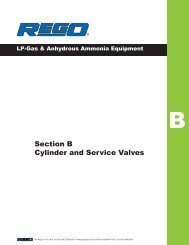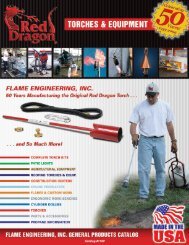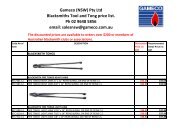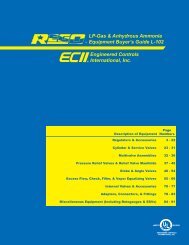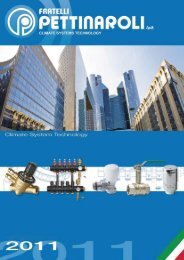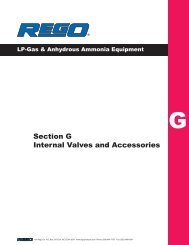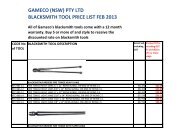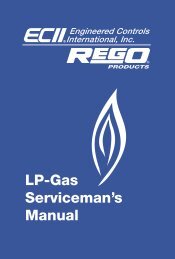Repair Kits Available By Part Number Section 2 Page - GAMECO
Repair Kits Available By Part Number Section 2 Page - GAMECO
Repair Kits Available By Part Number Section 2 Page - GAMECO
Create successful ePaper yourself
Turn your PDF publications into a flip-book with our unique Google optimized e-Paper software.
WARNING: Installation, disassembly, repair and maintenance<br />
must be performed only by qualified personnel.<br />
This valve must remain in the closed position except during<br />
product transfer. A line break downstream of the pump may fail to<br />
actuate the excess flow valve as the pump may limit flow. If a break<br />
occurs in the system, or the excess flow closes, immediately shut<br />
down the system.<br />
Installation, usage and maintenance of this product must be in<br />
compliance with all Engineered Controls International, Inc. instructions<br />
as well as requirements and provisions of NFPA #54, NFPA<br />
#58, DOT, ANSI, all applicable federal, state, provincial and local<br />
standards, codes, regulations and laws.<br />
Inspection and maintenance on a periodic basis is essential.<br />
Be sure all instructions are read and understood before installation,<br />
operation and maintenance. These instructions must be<br />
passed along to the end user of the product.<br />
CAUTION: Contact or inhalation of liquid propane, ammonia and<br />
their vapors can cause serious injury or death! NH3 and LP-Gas<br />
must be released outdoors in air currents that will insure dispersion<br />
to prevent exposure to people and livestock. LP-Gas must be kept<br />
far enough from any open flame or other source of ignition to<br />
prevent fire or explosion! LP-Gas is heavier than air and may not<br />
disperse or evaporate rapidly if released in still air.<br />
Foreword<br />
The A3209050 1 1 /4" Internal Valve is designed primarily for use with<br />
propane, butane and anhydrous ammonia. It is intended for use as<br />
a main valve on small capacity pump systems. It may also be<br />
installed in the vapor return line and liquid withdrawal openings on<br />
trucks or in-line installations and in nurse tanks provided proper<br />
piping configuration is used.<br />
How The Valve Works<br />
Refer to the drawings in Figure 1. View “A” shows the valve in the closed<br />
position, held without leakage by tank pressure and the valve’s closing<br />
spring. Actuation of the operating handle alone does not open the valve,<br />
it only allows pressure to equalize between the inlet and outlet of the<br />
valve by rapid bleeding of the product downstream. This equalized<br />
pressure then allows the valve to open via the excess flow spring.<br />
The valve is opened by moving the handle to mid-point, see view “B”.<br />
This moves the actuator to the equalizing position of the valve stem in<br />
the pilot opening, allowing more product to bleed downstream than if the<br />
handle was fully open.<br />
In a few seconds, the tank and downstream pressure will be equalized,<br />
allowing the excess flow spring to push the poppet to the open position,<br />
see view “C”. The handle should then be moved to the fully opened<br />
position.<br />
If the handle is quickly moved to the fully opened position, the pilot valve<br />
allows a small amount of bleed downstream, but much less than during<br />
rapid bleed, view “B”. This results in a longer pressure equalizing time<br />
before the valve can open.<br />
NOTE: The poppet will not open until outlet pressure approximates<br />
tank pressure!<br />
Once the poppet is open, flow greater than the excess flow spring rating,<br />
or a sufficient surge in force of the flow, forces the poppet closed against<br />
the excess flow spring, as seen in view “D”. The pilot valve in this position<br />
is open and allows a small amount of bleed downstream, but much less<br />
than during rapid bleed, view “B”.<br />
When the operating handle is moved to the closed position, the valve<br />
closes and a tight, leakproof seal is re-established as seen in view “A”.<br />
Valve Installation<br />
The valve may be installed in a full or half coupling.<br />
WARNING: Do not install the valve in any piping that will restrict the<br />
valve inlet or outlet!<br />
After valve, pump and system piping are fully installed, run a thorough<br />
leak test using a high quality leak detection solution. The unit must be<br />
leak-free before being placed in service. In addition, the system must<br />
be tested to assure proper excess flow valve operation by simulating a<br />
break downstream at the furthest point being protected at the lowest<br />
operating pressure.<br />
WARNING: This test must be performed in a safe location, as<br />
testing with flammable gas is extremely hazardous. Only authorized<br />
trained personnel should perform this test.<br />
NOTE: To provide excess flow protection, the flow rating of the pump,<br />
piping, valves, fittings and hose on the inlet and outlet sides of the valve<br />
must be greater than the flow rating of the valve. Any restrictions that<br />
reduce the flow to less than the excess flow valve rating will result in the<br />
excess flow valve not operating when required.<br />
A3209TL Latch Assembly Installation<br />
The A3209TL Latch Assembly for use with the A3209A050, is a<br />
remote release mechanism employing a fuse link with a 212° F.<br />
melting point. Refer to Figure 2 when installing the latch assembly.<br />
1. Remove lever stop pin located nearest the internal valve outlet with<br />
an appropriate wrench.<br />
2. Position latch hole openings with the threaded holes in the valve and<br />
insert screws and washers as shown in Figure 2. Secure screws<br />
tightly with an appropriate wrench.<br />
3. Check operation by moving the lever to the open position and<br />
securing it with the latch. Pull latch outward to return the lever to the<br />
closed position.<br />
4. A cable should be run from the latch to a remote release handle. The<br />
cable should be taut, and may require pulleys to keep the cable from<br />
restricting interference that would prohibit proper operation. The<br />
fusible link will melt if exposed to fire or heat over 212° F.<br />
CAUTION: Stay clear of the valve lever as it moves to the closed<br />
position when unlatching.<br />
Cable Control System<br />
The cable control system employed must meet the requirements and be<br />
in accordance with the provisions of NFPA #58, DOT, ANSI, and all<br />
applicable federal, state, provincial and local codes.<br />
Valve Operation and Precautions<br />
1. Valve must be opened before starting pump, and before opening<br />
valve on pump outlet.<br />
2. Leave pumping system “wet” to avoid drying of seals and to reduce<br />
time involved in opening valve. Drain piping only when required by<br />
codes or safe operating practices.<br />
3. When piping is dry or at a lower pressure than the tank, open valve<br />
half-way for a few seconds to allow line pressure to equalize before<br />
fully opening the valve handle. The poppet may not open immediately<br />
if the handle is placed in the open position too quickly.<br />
4. Flow surges may close the built-in excess flow valve and should be<br />
avoided. If the excess flow valve slams shut; stop the pump, close<br />
the nearest downstream valve, and move handle to the mid-point<br />
position to equalize pressure until valve reopens with a click, then<br />
restart pump and open downstream valve slowly.<br />
5. Always keep valve closed except during product transfer.<br />
6. Completely open all valves during pumping. <strong>Part</strong>ially closed valves<br />
may prevent excess flow valve from closing when required, even in<br />
a properly designed piping system.<br />
7. All personnel must be aware of remote closure locations and their<br />
operation in case of an emergency. They must also be aware of the<br />
equalizing opening through which bleeding can occur after the<br />
excess flow valve closes. If this bleed is not stopped by closing a<br />
downstream valve, a hazard may occur.<br />
Troublshooting<br />
1. Internal Valve Will Not Open<br />
Causes may be excess leakage downstream, pump engaged too<br />
quickly, excessive wear of the valve, or ice accumulation.<br />
When there is excessive volume downstream, a greater amount of<br />
time is required to equalize tank and downstream pressure.



